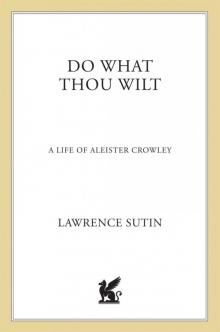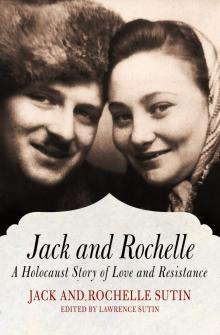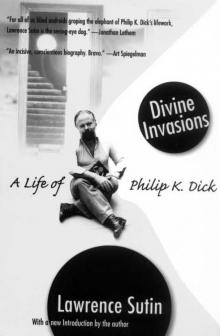- Home
- Lawrence Sutin
Do What Thou Wilt
Do What Thou Wilt Read online
The author and publisher have provided this e-book to you for your personal use only. You may not make this e-book publicly available in any way. Copyright infringement is against the law. If you believe the copy of this e-book you are reading infringes on the author’s copyright, please notify the publisher at: us.macmillanusa.com/piracy.
CONTENTS
Title Page
Copyright Notice
Acknowledgments
INTRODUCTION
An Overview of the Magical Tradition, in Which It Is Suggested that the Raging Battle Between Jesus and Satan Be (For the Moment) Set Aside in Order that the True Nature of the Magus Be Understood
ONE
The Strange Transformation of One Edward Alexander (“Alick”) Crowley, a Pious Christian Boy of the Late Victorian Upper Class, Into Aleister Crowley, Poet, Gent., and Magical Adept in Waiting (1875–98)
TWO
In Which Aleister Crowley Takes the Magical Name Perdurabo (“I Shall Endure to the End”) But Appears to Lose His Way Amidst the Schisms of The Golden Dawn and the Temptations of the Vale of Tears (1898–1900)
THREE
Years of Wandering in Which Crowley Pursues the Heights of Magic and Mountains, Embraces Buddhism, Then Abandons All for the Love of a Woman and the Life of Country Laird (1900–04)
FOUR
The Birth of the New Aeon (1904–05)
FIVE
The Assault on Kanchenjunga, the Establishment of a New Magical Order, and the Wanderlusts of a Magus (1905–08)
SIX
The Creation of The Equinox, the Rites of Eleusis, and a Confrontation in the Sahara with the God of Chaos (1909–14)
SEVEN
In Exile in America, Crowley Endures Poverty and Accusations of Treason as Ordeals Necessary to Becoming a Magus (1914–19)
EIGHT
The Founding and the Ruin of the Abbey of Thelema (1920–23)
NINE
Years of Exile and Wandering—and the Publication of a Masterwork (1923–30)
TEN
A Staged Suicide, an Unavenged Libel, and the Equinox of the Gods (1930–36)
ELEVEN
The Final Years of a Magus in the Guise of a Disreputable Old Man (1937–47)
EPILOGUE
An Assortment of Posthumous Assessments and Developments
Endnotes
Selected Bibliography
Index
Also by Lawrence Sutin
Copyright
ACKNOWLEDGMENTS
The researching and writing of this biography has occupied a goodly portion of my time over the decade 1989–99. It would be impossible to thank everyone who assisted me with information and moral support over that period. But the following persons and institutions deserve mention here.
The initial inspiration to write a life of Aleister Crowley came from my good friend Greg Overlid, a resolute explorer of conceptual frameworks. Another dear friend and fellow writer, Marshall Fine, commiserated with me throughout the winding emotional road from initial proposal to final publication.
The staffs of the Warburg Institute, University of London; the Harry Ransom Humanities Research Center, University of Texas at Austin; the Liddell Hart Center for Military Archives, King’s College, University of London; the British Museum, London; and the Wren Library, Trinity College, Cambridge University, were helpful during my researches at those institutions. While in Great Britain from January to April 1990, I enjoyed the hospitality of several persons knowledgeable as to Crowley, notably Geraldine Beskin, Richard Cavendish, Nicolas Culpepper, Clive Harper, Francis X. King, Anthony Naylor, Keith Richmond, Timothy d’Arch Smith, Stephen Skinner, Michael Staley and Isabel Sutherland. Upon my return to the United States, I drew upon the Crowley expertise and archives of Gerald and Marlene Cornelius and William E. Heidrick.
Throughout the entire decade of work, the support and friendship of Hymenaeus Beta, Frater Superior, O.T.O., has been of enormous value. It was he who was the sole reader of my initial draft—in excess of 1,800 pages—and it was he who kindly and thoroughly scrutinized the final version that is now before the reader. No other person outside of St. Martin’s Press has so served as reader and querent, and no other person could have done so fine a job. While Hymenaeus Beta is a religionist and I am an outsider and skeptic with respect to the Thelemic creed, his criticisms of my writing were always respectful and made in the service of factual truth. Nonetheless, he and I disagree on numerous points as to the interpretation of Crowley’s life, and my views as set forth in this book should not be mistaken as representing his own. Naturally, any errors that remain in the text are solely my responsibility.
As for my wife, Mab, who bore with me through years of labor that did little to support our family, and that are likely to receive little thanks from the world at large, words fail me.
INTRODUCTION
An Overview of the Magical Tradition, in Which It Is Suggested that the Raging Battle Between Jesus and Satan Be (For the Moment) Set Aside in Order that the True Nature of the Magus Be Understood
Biographers are fond of observing that their subjects have been much misunderstood.
Among other reasons, this view serves nicely to justify their labors. Why trouble the reader with a fresh portrait when clarity reigns?
In the case of Aleister Crowley (1875–1947), one is compelled to conclude that he has been as greatly misunderstood as any biographer could wish. In truth, “misunderstanding” hardly serves to convey the degree of hatred and fear which the name of Crowley—aka “The Great Beast” and “The Wickedest Man on Earth”—continues to inspire to the present day. The popular image endures of Crowley as a vicious Satanist who employed illicit drugs and perverted sex to enliven the weary charade of his blasphemous “magick” (Crowley’s own distinctive spelling for his development of traditional magic).
Virtually every current handbook on the “cult crisis” in America features a purple-prose paragraph on the sinister Crowley who has inspired numberless depravities culminating in ritual rape and murder. Amongst scholars, it is common to dismiss Crowley as “notorious” and his theories as “mercifully obscure” without having scrupled to read his books. To question this blackest of black assessment of Crowley—merely to suggest a touch of gray—is to inspire suspicion that you are in cahoots with the Satanists.
Crowley is, admittedly, a complicated case. One can hardly blame people for feeling hatred and fear toward Crowley when Crowley himself so often exulted in provoking just such emotions. Indeed, he tended to view those emotions as inevitable, given what he regarded as the revolutionary nature and power of his teachings and the prevailing hypocrisy of society—and not merely that of his native Britain, mind you, but of the whole of the Christianized West and, for good measure, of the entire unawakened world. Antagonism toward the religious powers that be was the essence of Crowley’s vision of his life and of his mission—Crowley who brandished and popularized his role as the “Beast” of Revelations come to life, the selfsame 666 proclaimed in the Biblical text as “the number of a man.” Small wonder that the evils of Satanism are laid at his feet. As one disciple of the Beast has observed, “There is no sense in trying to whitewash Crowley’s reputation. Aleister spent most of his life systematically blackening it.”
Clearly, this Crowley fellow was an egregious sort—a shameless scoffer at Christian virtue, a spoiled scion of a wealthy Victorian family who embodied many of the worst John Bull racial and social prejudices of his upper-class contemporaries, a blisteringly arrogant opportunist who took financial and psychological advantage of his admirers, an unadmiring and even vicious judge of most of his contemporaries, a sensualist who relished sex in all forms, a hubristic experimenter in drugs who was addicted to hero
in for the last twenty-five years of his life. No question that the sheer egotistical bombast of the man could be stupefying. For the Beast regarded himself as no less than the Prophet of a New Aeon that would supplant the Christian Era and bring on the reign of the Crowned and Conquering Child, embodiment of a guiltless, liberated humanity that had, at last, chosen to become the gods it had merely worshiped in the past.
But as for any alleged sympathy with the Christian Devil, Crowley viewed Satanism as a tawdry sport unworthy of his time and skills. Satanism depends, for its demonic fervor, on the dialectical existence of a vibrant Christianity that it can revile. The archetypal Satanic rite, the Black Mass, is structured closely upon the Catholic Mass. The catharsis of the Black Mass stems from the impassioned belief that ritual desecration—compelling Christ to appear in the Host at the command and under the power of Satan—is a sizzling blasphemy. Satanism forms a syzygy with Christianity—an intertwined, oppositional heresy asserting the power of the Adversary as against the reign of the Son, a reign which alone gives the Black Mass its meaning. Crowley, the Beast, the Prophet, wanted far more. Revile Christianity (but not Christ, mind you) as he might, seek its downfall as he did, Crowley desired nothing less than the creation of a full-fledged successor religion—complete with a guiding Logos that would endure for millennia, as had the teachings of Jesus. “Thelema” was the Logos Crowley proclaimed, Greek for “Will.” “Do what thou wilt shall be the whole of the law” was its central credo. Let us concede that this credo—so redolent, seemingly, of license and anarchy, dark deeds and darker dreams—terrifies on first impact, as does Crowley the man.
Crowley makes for a grippingly vile Gothic protagonist. He has been a popular model for fiction writers in search of villains with the requisite chill. W. Somerset Maugham devoted a novel, The Magician (1906), to Crowley’s malevolent charms; other fiction writers who have modeled villains on the Beast include James Branch Cabell, Dion Fortune, Christopher Isherwood, M. R. James, Anthony Powell, H. R. Wakefield, Dennis Wheatley, Colin Wilson, and Robert Anton Wilson. The British playwright Snoo Wilson scored a London stage hit in the 1970s with his play The Beast. Crowley’s exotic appeal has not been limited to literature. Since his appearance on the cover of The Beatles’ album Sgt. Pepper’s Lonely Hearts Club Band (1967)—a photo of Crowley with shaven head and piercing eyes, his most enduring iconographic image—the Beast has endured in the world of rock music in various guises, influencing the lyrics of the Rolling Stones, Led Zeppelin, David Bowie, Darryl Hall, Sting, Ozzy Osbourne, The Clash, and The Cure, not to mention scores of less familiar hardcore, punk, and industrial bands. It would seem that Crowley is as irresistible a fantasy for the counterculture (which typically casts him as a defiant rebel who stood for individual freedom first and foremost, this despite Crowley’s lifelong aristocratic—and even, at times, fascistic—bent in politics) as he is for Christian fundamentalists (who have, paradoxically, succeeded in perpetuating Crowley’s fame by casting him as the Evil Exemplar best suited to sustain a healthy fear of the Devil in the faithful).
* * *
But beneath the greasepaint of these popular images, does there remain a Crowley worthy of the serious attention of the intelligent reader?
It is the claim of this biography that such a Crowley does exist. Indeed, as the twentieth century has come to a close, it is clear that Crowley stands out as one of its more remarkable figures. A “minor” figure he may be, if one measures him on a scale of ultimate deeds. But such calipers will nullify all but a handful of those who shaped our times. Crowley is most emphatically a part of the spiritual history of this century, and as such it behooves us to reckon with him both sensibly and sensitively. Say what you will of Crowley, judge his failings as you will, there remains a man as protean, brilliant, courageous, and flabbergasting as ever you could imagine. There endure achievements that no reasoned account of his life may ignore.
Consider, briefly for now, the foremost of these:
(1). Crowley was an inveterate and adventurous traveler as well as an accomplished mountain climber who tested his skills on two of the most difficult Himalayan peaks—K2 and Kanchenjunga.
(2). Crowley was one of the first Western students of Buddhism and yoga to approach these teachings not as primitive or exotic theories, but rather as modes of spiritual development that had to be gauged experientially. In this, Crowley anticipated the spread of Eastern spiritual practice in the West.
(3). Crowley was a prolific poet who displayed, intermittently, a pure and genuine talent. This was acknowledged by otherwise unadmiring contemporaries such as G. K. Chesterton and William Butler Yeats (for whose famous poem “The Second Coming” with its “rough beast, its hour come round at last,” Crowley may have been a source of influence). Further, Crowley wrote (usually under pseudonymous guises) some of the most daringly original—and unrecognized—homoerotic poems of this century. Crowley consciously utilized poetry to explore his forbidden bisexuality and to defy cultural taboos. The standard surveys of twentieth-century gay literature will someday be revised to take in Crowley’s contributions.
(4). Crowley was a gifted fiction writer whose occult narratives, in particular, place him in the supernatural tale tradition of Algernon Blackwood, Arthur Machen, and H. P. Lovecraft—a tradition that exercises an ongoing influence on the popular modern-day horror and science-fiction genres.
(5). Crowley was a scholar of depth and breadth whose researches bore such creative fruit as, for example, a radically new design for the traditional Tarot deck. The “Crowley deck,” as it is popularly termed, remains in wide use today.
(6). As a prose stylist, Crowley was a master Modernist whose fierce impatience with restrictions on form and thought link him to fellow iconoclasts of his era such as D. H. Lawrence, Wyndham Lewis, and Ezra Pound.
(7). Crowley was—again, like D. H. Lawrence—a technically unsophisticated but viscerally compelling painter in what might loosely be called the Expressionist mode. Crowley’s canvases, which are today avidly sought out by collectors, create a jarring impact by virtue of their swirling color sense—hot, bright yellows, etched wounds of reds, blues from the dead of night.
(8). Crowley was a mystical writer of rare sophistication and originality, one who brilliantly reformulated, into twentieth-century terms, the vital insights of the Western esoteric tradition—a tradition that extends across recorded history, from the legends of King Solomon and the Egyptian Hermes Trismegistus through the writings of the Gnostics and Neoplatonists to the alchemists, Rosicrucians, and Freemasons. Crowley thus may fairly (or unfairly, depending upon one’s point of view) be regarded as the primary fount of that diverse, fertile, and occasionally ridiculous range of movements loosely termed “New Age.”
(9). Crowley was one of the rare human beings of this or any age to dare to prophesy a distinctive new creed and to devote himself—with some success—to the promulgation of that creed. Adherents of Crowley the Prophet of Thelema (we are not speaking here of self-styled Satanists who shave their heads and parrot random phrases from Crowley’s writings) number in the low thousands worldwide—a less than imposing figure, but one that fails to take into account a high level of organization, ongoing publishing efforts, and ardent devotion to the cause.
Whether or not one agrees with any or all of the teachings of Thelema can remain, for present purposes, a secondary concern for the reader, who may rest assured that this biography seeks neither to encourage nor to dissuade potential “converts.” As Edward Gibbon observed: “For the man who can raise himself above the prejudices of party and sect, the history of religion is the most interesting part of the history of the human spirit.” Crowley’s heights and depths are no mere heresies and phantasms, but rather the possibilities—and, at times, distant foreshadowings, for Crowley dared greatly and roamed wildly—of that human spirit.
But for all Crowley’s accomplishments, a gulf in sympathy with our protagonist is likely to have persisted in the reader. The figure of Ale
ister Crowley remains strangely alien, particularly when one attempts to assimilate him into the standard frameworks of cultural achievement.
The reason for this has to do—in large measure—with the perplexing nature of the Western esoteric tradition from which Crowley springs. More particularly, it has to do with the scorn and befuddlement which flood the thoughts of most persons today when the subject of magic is broached.
For Crowley was first and foremost a magus: a devoted adept of the art of high magic.
Hearing the word “magic,” too many are likely to think of a discomfited rabbit being yanked by the ears from a trick top hat. Or perhaps there arises the vision of a Faust-like spiritual miscreant who enters into the legendary pact with the Devil: giddying forbidden powers that grant a mere spree of earthly delight in exchange for one’s eternal soul.
If Crowley is to be understood, it is essential also to understand—at least in basic terms—the history of magical thought and practice in the West. In so doing, one must bear in mind the dilemma posed by Isaac Bashevis Singer with regard to the occult tradition—that “we are living in an era of amnesia. We have forgotten those vital truths that man once knew and by whose strength he lived.”
Crowley recognized the dilemma full well. The era of amnesia had induced not merely forgetfulness but also outright contempt for the tradition he revered and equated with the highest forms of mysticism. In his masterwork, Magick in Theory and Practice (1930), Crowley explained that his own term, “Magick,” was to be distinguished from the “Magic” that had attracted “dilettanti and eccentrics” who sought “an escape from reality.” Crowley quite honorably confessed that “I myself was first consciously drawn to the subject in this way.” But this early infatuation with the sheer mystery of the occult was soon supplanted by something far stronger, as Crowley underscored through the use of a typographical emphasis—akin, in its effect, to concrete poetry—that transforms the plain prose page into a kind of magical invocation:

 Do What Thou Wilt
Do What Thou Wilt Jack and Rochelle
Jack and Rochelle Divine Invasions: A Life of Philip K. Dick
Divine Invasions: A Life of Philip K. Dick